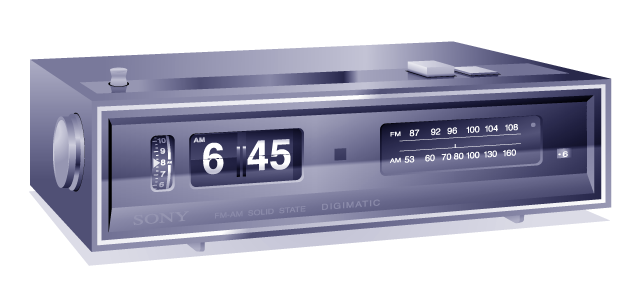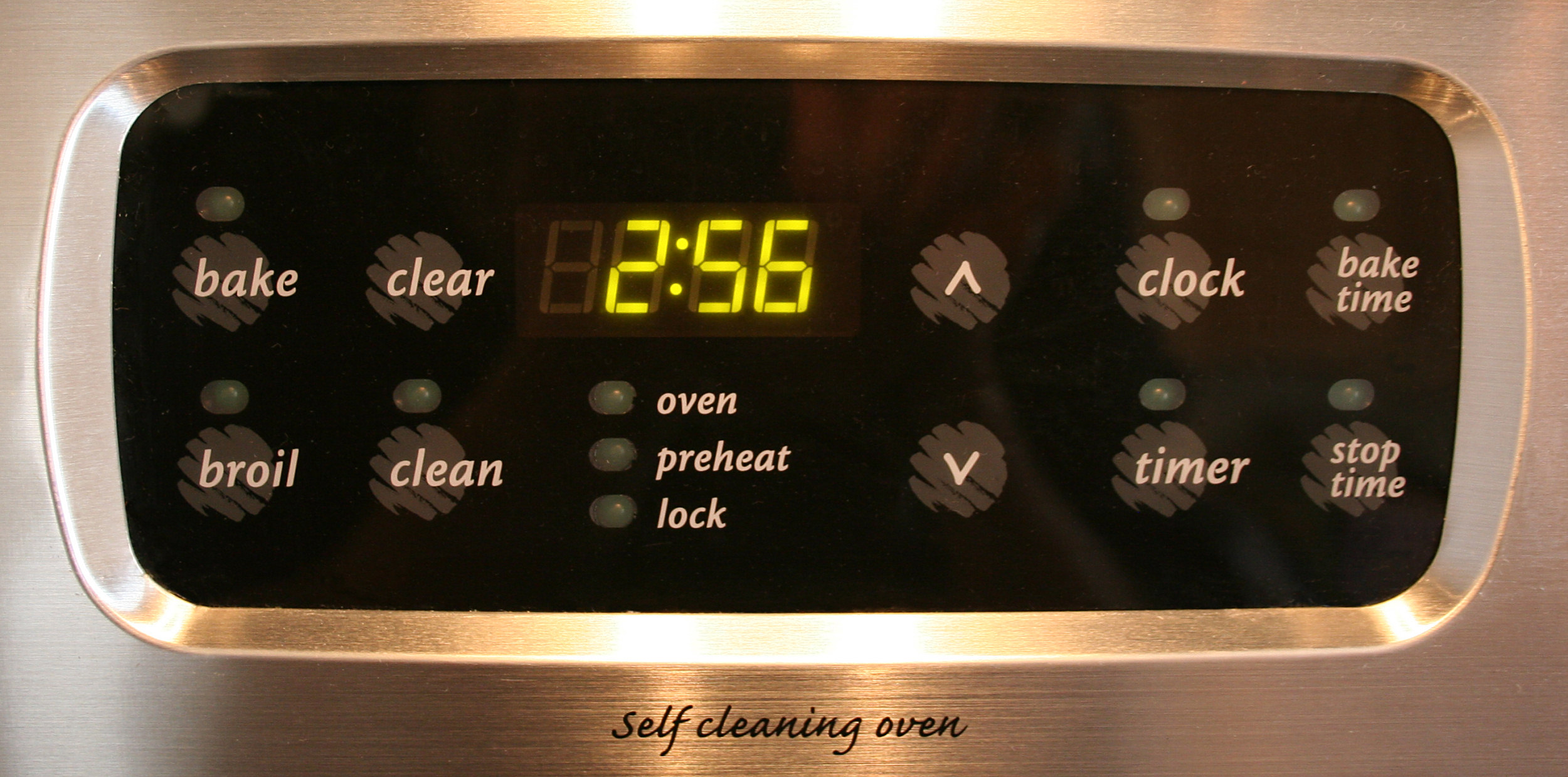Digital clock on:
[Wikipedia]
[Google]
[Amazon]

 A digital clock is a type of
A digital clock is a type of
 To represent the time, most digital clocks use a seven-segment LED, VFD, or LCD for each of four digits. They generally also include other elements to indicate whether the time is AM or PM, whether or not an alarm is set, and so on. Older digital clocks used numbers painted on wheels, or
To represent the time, most digital clocks use a seven-segment LED, VFD, or LCD for each of four digits. They generally also include other elements to indicate whether the time is AM or PM, whether or not an alarm is set, and so on. Older digital clocks used numbers painted on wheels, or
File:LCD Clock Grey.jpg, An LCD battery-operated clock without alarm
File:Digital-clock-radio-premium.jpg, A premium digital clock radio with digital tuning
File:Digital-clock-radio-basic hf.jpg, A basic digital clock radio with analog tuning
File:LCD_Clock.jpg, Transflective LCD battery-operated clock with radio time setting

 Because digital clocks can be very small and inexpensive devices that enhance the popularity of product designs, they are often incorporated into all kinds of devices such as cars, radios,
Because digital clocks can be very small and inexpensive devices that enhance the popularity of product designs, they are often incorporated into all kinds of devices such as cars, radios,
History of the Digital Watch
Museum of Vintage Rare Digital LCD Wrist Watches
{{Authority control Austrian inventions Clock designs

 A digital clock is a type of
A digital clock is a type of clock
A clock or a timepiece is a device used to measure and indicate time. The clock is one of the oldest human inventions, meeting the need to measure intervals of time shorter than the natural units such as the day, the lunar month and ...
that displays the time digitally (i.e. in numerals or other symbols), as opposed to an analogue clock.
Digital clocks are often associated with electronic drives, but the "digital" description refers only to the display, not to the drive mechanism. (Both analogue and digital clocks can be driven either mechanically or electronically, but "clockwork" mechanisms with digital displays are rare).
History
The first digital pocket watch was the invention of Austrian engineer Josef Pallweber who created his "jump-hour" mechanism in 1883. Instead of a conventional dial, the jump-hour featured two windows in an enamel dial, through which the hours and minutes are visible on rotating discs. The second hand remained conventional. By 1885 Pallweber mechanism was already on the market in pocket watches byCortébert
Cortébert is a municipality in the Jura bernois administrative district in the canton of Bern in Switzerland. It is located in the French-speaking part of the canton in the Jura mountains.
History
Cortébert is first mentioned in 1178 as ...
and IWC; arguably contributing to the subsequent rise and commercial success of IWC. The principles of Pallweber jump-hour movement had appeared in wristwatches by the 1920s (Cortébert) and are still used today ( Chronoswiss Digiteur). While the original inventor didn't have a watch brand at the time, his name has since been resurrected by a newly established watch manufacturer.
Plato clocks used a similar idea but a different layout. These spring-wound pieces consisted of a glass cylinder with a column inside, affixed to which were small digital cards with numbers printed on them, which flipped as time passed. The Plato clocks were introduced at the St. Louis World Fair in 1904, produced by Ansonia Clock Company. Eugene Fitch of New York patented the clock design in 1903.
13 years earlier Josef Pallweber had patented the same invention using digital cards (different from his 1885 patent using moving disks) in Germany (DRP No. 54093).
The German factory Aktiengesellschaft für Uhrenfabrikation Lenzkirch
Aktiengesellschaft für Uhrenfabrikation Lenzkirch (''Public company for clockmaking Lenzkirch'') was founded in 1851 in the village of Lenzkirch in Baden by Eduard Hauser who had trained in France and Switzerland. It is in the tradition of Blac ...
made such digital clocks in 1893 and 1894.
The earliest patent for a digital alarm clock was registered by D.E Protzmann and others on October 23, 1956, in the United States. Protzmann and his associates also patented another digital clock in 1970, which was said to use a minimal amount of moving parts. Two side-plates held digital numerals between them, while an electric motor and cam gear outside controlled movement.
In 1970, the first digital wristwatch with an LED display was mass-produced. Called the Pulsar, and produced by the Hamilton Watch Company, this watch was hinted at two years prior when the same company created a prototype digital watch for Kubrick's '' 2001: A Space Odyssey''.
Construction
Digital clocks typically use the 50 or 60hertz
The hertz (symbol: Hz) is the unit of frequency in the International System of Units (SI), equivalent to one event (or cycle) per second. The hertz is an SI derived unit whose expression in terms of SI base units is s−1, meaning that o ...
oscillation of AC power or a 32,768 hertz crystal oscillator as in a quartz clock
Quartz clocks and quartz watches are timepieces that use an electronic oscillator regulated by a quartz crystal to keep time. This crystal oscillator creates a signal with very precise frequency, so that quartz clocks and watches are at leas ...
to keep time. Most digital clocks display the hour of the day in 24-hour format
The modern 24-hour clock, popularly referred to in the United States as military time, is the convention of timekeeping in which the day runs from midnight to midnight and is divided into 24 hours. This is indicated by the hours (and minutes) pa ...
; in the United States and a few other countries, a commonly used hour sequence option is 12-hour format (with some indication of AM or PM). Some timepieces, such as many digital watches, can be switched between 12-hour and 24-hour modes. Emulations of analog-style faces often use an LCD screen, and these are also sometimes described as "digital".
Displays
 To represent the time, most digital clocks use a seven-segment LED, VFD, or LCD for each of four digits. They generally also include other elements to indicate whether the time is AM or PM, whether or not an alarm is set, and so on. Older digital clocks used numbers painted on wheels, or
To represent the time, most digital clocks use a seven-segment LED, VFD, or LCD for each of four digits. They generally also include other elements to indicate whether the time is AM or PM, whether or not an alarm is set, and so on. Older digital clocks used numbers painted on wheels, or split-flap display
A split-flap display, or sometimes simply a flap display, is a digital electromechanical display device that presents changeable alphanumeric text, and occasionally fixed graphics.
Often used as a public transport timetable in airports or ...
. High-end digital clocks use dot matrix displays and use animations for digit changes.
Setting
If people find difficulty in setting the time in some designs of digital clocks in electronic devices where the clock is not a critical function, they may not be set at all, displaying the default after powered on, 00:00 or 12:00. Because they run on electricity, digital clocks often need to be reset whenever the power is cut off, even for a very brief period of time. This is a particular problem with alarm clocks that have no "battery" backup, because a power outage during the night usually prevents the clock from triggering the alarm in the morning. To reduce the problem, many devices designed to operate on household electricity incorporate abattery
Battery most often refers to:
* Electric battery, a device that provides electrical power
* Battery (crime), a crime involving unlawful physical contact
Battery may also refer to:
Energy source
*Automotive battery, a device to provide power t ...
backup to maintain the time during power outages and during times of disconnection from the power supply. More recently, some devices incorporate a method for automatically setting the time, such as using a broadcast radio
Radio is the technology of signaling and communicating using radio waves. Radio waves are electromagnetic waves of frequency between 30 hertz (Hz) and 300 gigahertz (GHz). They are generated by an electronic device called a tr ...
time signal from an atomic clock
An atomic clock is a clock that measures time by monitoring the resonant frequency of atoms. It is based on atoms having different energy levels. Electron states in an atom are associated with different energy levels, and in transitions betwe ...
, getting the time from an existing satellite television
Satellite television is a service that delivers television programming to viewers by relaying it from a communications satellite orbiting the Earth directly to the viewer's location. The signals are received via an outdoor parabolic antenna com ...
or computer
A computer is a machine that can be programmed to carry out sequences of arithmetic or logical operations ( computation) automatically. Modern digital electronic computers can perform generic sets of operations known as programs. These prog ...
connection, or by being set at the factory and then maintaining the time from then on with a quartz movement powered by an internal rechargeable battery.
Commercial digital clocks are typically more reliable than consumer clocks. Multi-decade backup batteries can be used to maintain time during power loss.
Uses

television
Television, sometimes shortened to TV, is a telecommunication medium for transmitting moving images and sound. The term can refer to a television set, or the medium of television transmission. Television is a mass medium for advertising, ...
s, microwave ovens, standard ovens, computers and cell phones. Sometimes their usefulness is disputed: a common complaint is that when time has to be set to Daylight Saving Time, many household clocks have to be readjusted. The incorporation of automatic synchronization by a radio time signal is reducing this problem (see Radio clock). Smart digital clocks, in addition to displaying time, scroll additional information such as weather and notifications.
References
External links
History of the Digital Watch
Museum of Vintage Rare Digital LCD Wrist Watches
{{Authority control Austrian inventions Clock designs
Clock
A clock or a timepiece is a device used to measure and indicate time. The clock is one of the oldest human inventions, meeting the need to measure intervals of time shorter than the natural units such as the day, the lunar month and ...